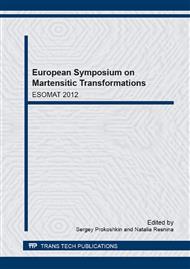p.301
p.306
p.311
p.316
p.321
p.326
p.332
p.338
p.344
Structure, Phase Transformations and Properties of Rapidly Quenched Ti2NiCu Alloys
Abstract:
Methods of X-ray diffraction, transmission and scanning electron microscopy, and electron diffraction have been used to study phase and chemical compositions and structure of Ti2NiCu alloys. The alloys of the quasi-binary section TiNi–TiCu, which exhibit in the initial as-cast state thermoelastic martensitic transformations B2↔B19 and related shape memory effects, have been produced by rapid quenching of the melt (melt spinning technique). The chemical composition of the Ti2NiCu alloys was varied with respect to titanium and nickel within x ≤ ±1 at. %. The mechanical properties of the alloys have been measured in the initial state and after subsequent heat treatment. The kinetics of the crystallization from the amorphous state, devitrification processes and the forward and reverse thermoelastic martensitic transformations were investigated. Their characteristic temperatures have been determined by measuring temperature dependences of the electrical resistivity of the alloys. The diagram of the dependence of the critical temperatures on the chemical composition has been constructed.
Info:
Periodical:
Pages:
321-325
Citation:
Online since:
January 2013
Authors:
Price:
Сopyright:
© 2013 Trans Tech Publications Ltd. All Rights Reserved
Share:
Citation:


